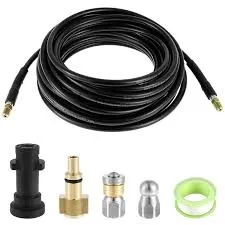jeep cherokee power steering hose
Understanding the Power Steering Hose of the Jeep Cherokee
When it comes to maintaining the performance and safety of your Jeep Cherokee, one of the often-overlooked components is the power steering system, particularly the power steering hose. This flexible tube plays a crucial role in the steering mechanism, enabling smooth and responsive handling. Understanding its function, maintenance, and potential issues can help ensure your Jeep Cherokee remains reliable on and off the road.
What is the Power Steering Hose?
The power steering hose is a vital component that connects the power steering pump to the steering gear or rack. Its primary purpose is to transport hydraulic fluid, which is essential for providing the necessary force to assist with steering. The power steering pump generates this hydraulic fluid under pressure, making it easier for drivers to turn the steering wheel, especially at low speeds or when parking.
The Jeep Cherokee typically employs two types of hoses the high-pressure hose and the low-pressure return hose
. The high-pressure hose carries fluid from the pump to the steering gear under high pressure, while the low-pressure return hose returns the fluid back to the pump after it has fulfilled its purpose.Signs of a Failing Power Steering Hose
Like any component of a vehicle, the power steering hose can wear out over time. It’s essential to recognize the signs of a potential failure. One of the most common indicators is the presence of fluid leaks. If you notice fluid pooling under your Cherokee, it could indicate a leak in the hose. Additionally, if you experience difficulty steering, especially if you hear whining noises when turning the wheel, it’s crucial to check the power steering fluid level and inspect the hoses for damage.
jeep cherokee power steering hose

Another sign of a failing power steering hose is a spongy or loose feeling in the steering wheel. This can happen if the hose is compromised and not allowing enough hydraulic fluid to assist in steering. In such instances, addressing the issue promptly is essential to avoid more significant damage to the power steering system or components.
Maintenance Tips
Regular maintenance can extend the lifespan of the power steering hose in your Jeep Cherokee. Start by inspecting the hoses for any visible signs of wear, such as cracks or bulges. Ensure that the connections to the power steering pump and steering gear are secure. It’s also a good practice to check the power steering fluid level regularly and top it off as needed, as low fluid levels can increase pressure on the hoses and lead to premature wear.
If you notice any leaks or signs of wear, it’s advisable to replace the power steering hose promptly. It’s a relatively straightforward process that can often be handled by a skilled DIYer but may require professional assistance for those less experienced.
Conclusion
The power steering hose in your Jeep Cherokee is essential for safe and effective steering. Understanding its function, recognizing the signs of a potential failure, and performing regular maintenance can help keep your vehicle running smoothly. By paying attention to this often-overlooked component, you can enjoy a more reliable and enjoyable driving experience, whether on rugged trails or city streets. Keep your Jeep Cherokee in top shape by giving the power steering hose the attention it deserves!
-
Ultimate Spiral Protection for Hoses & CablesNewsJun.26,2025
-
The Ultimate Quick-Connect Solutions for Every NeedNewsJun.26,2025
-
SAE J1401 Brake Hose: Reliable Choice for Safe BrakingNewsJun.26,2025
-
Reliable J2064 A/C Hoses for Real-World Cooling NeedsNewsJun.26,2025
-
Heavy-Duty Sewer Jetting Hoses Built to LastNewsJun.26,2025
-
Fix Power Steering Tube Leaks Fast – Durable & Affordable SolutionNewsJun.26,2025

